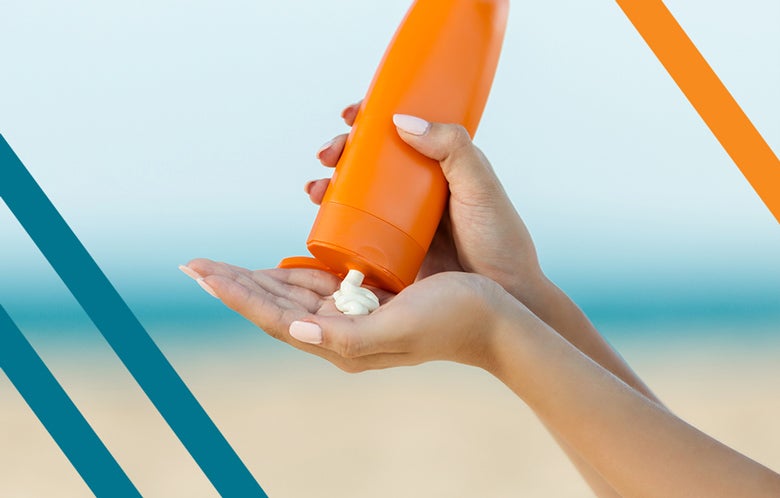Wear sunscreen to protect against skin cancer. You have likely heard this advice repeated, especially when the weather is warm. There is even a popular spoken word song about it from Baz Luhrmann, originally written by columnist Mary Schmich in 1997. Skincare items like facial moisturizers and body lotions often have sunscreen built in, making it even easier to protect yourself from the sun as part of your everyday routine. A randomized trial recently published in JAMA appears at first glance to call into question this longstanding advice.
The FDA conducted a maximal usage sunscreen study randomizing 48 participants to one of four different formulations of sunscreen products: lotion, aerosol spray, non-aerosol spray and pump spray. The product composition of each formulation varied, including different numbers of active ingredients as well as different component concentrations, but all products contained three percent weight/volume avobenzone. Each participant had two mg/cm2 of the randomized product applied to 75 percent of their body surface area (covering all skin outside of normal swimwear) up to four times per day for four days and were kept in the clinic for seven days with no exposure to direct sunlight. The maximum plasma concentration (highest concentration observed over the duration of the trial) of each active ingredient was determined over 21 days from first sunscreen exposure and assessed based on a maximum systemic exposure threshold of 0.5 ng/mL.
The mean maximum plasma concentration for each active ingredient greatly exceeded the 0.5 ng/mL threshold, ranging from 3.3 ng/mL to 7.1 ng/mL avobenzone (primary outcome). Concentrations were consistently higher for lotion formulations compared to spray products. Plasma concentration of each product generally peaked after four days of consistent application and were often still above 0.5 ng/mL on day 21, 17 days after product discontinuation.
So, what does this mean? Is sunscreen now a risk factor for the development of cancer and not a tried and true method of cancer risk reduction? Let’s break down some of the many limitations of this sunscreen study.
Though this study does warrant follow-up, these very preliminary results do not suggest that sunscreen is dangerous.
Though this study does warrant follow-up, these very preliminary results do not suggest that sunscreen is dangerous.
First, as a maximal usage trial, the methodology doesn’t exactly mirror real-world sunscreen usage. While two mg/cm2 is the amount of sunscreen needed to get labeled SPF protection, individuals applying sunscreen usually only apply 25-75 percent of this recommended amount. Using less sunscreen means you are less protected, with most users only achieving 20-50 percent of the SPF labeled protection. This lower than expected protection is why products with SPF of at least 30 are most commonly recommended by healthcare providers. Although the trial did specify the percent weight/volume of each active ingredient in each product, the SPF rating was not provided, making it harder to translate these findings into real world scenarios. Additionally, the participants in the trial stayed in the clinic for seven days and were not exposed to direct sunlight. This allowed the researchers to more tightly control the trial environment but does not account for conditions that a sunscreen wearer is generally exposed to such as sun, heat, sweat, and water.
Secondly, maximum plasma concentrations of sunscreen active ingredients is a surrogate outcome that does not appear to have any link to a clinical outcome. While the study suggests a link to cancer, a check of the references leads to an FDA document on Sunscreen Drug Products for Over-the-Counter Human Use that states, “The threshold value of 0.5 ng/mL is based on the assessment that the level would approximate the highest plasma level below which the carcinogenic risk of any unknown compound would be less than 1 in 100,000 after a single dose.” This threshold was chosen not because any data suggests sunscreen products increase the risk for cancer, but because it’s a general threshold used for any compound with unknown carcinogenic risk. Finally, while the mean maximum plasma concentrations were consistently higher than 0.5 ng/mL (and who knows what that means), there was a huge amount of variability. The wide range of results was never discussed, but this could suggest factors other than formulation affect absorption.
There are several additional limitations to this sunscreen study that further undermine the bottom line, including small group size (only 12 participants per group), no intention-to-treat analysis (time points were excluded if the participant did not receive a dose or showered too close to a dose) and baseline differences (such as Fitzpatrick skin type).
Though this study does warrant follow-up, these very preliminary results do not suggest that sunscreen is dangerous. What is more dangerous is the publication of this trial in a high-profile journal where the results may be misinterpreted and lead to sunscreen avoidance. While the last line of the abstract states, “These findings do not indicate that individuals should refrain from the use of sunscreen,” the trial plants the idea that sunscreen usage may be linked to cancer without any actual evidence to support this notion. Don’t believe the hype, always look at the evidence and continue to wear sunscreen.



